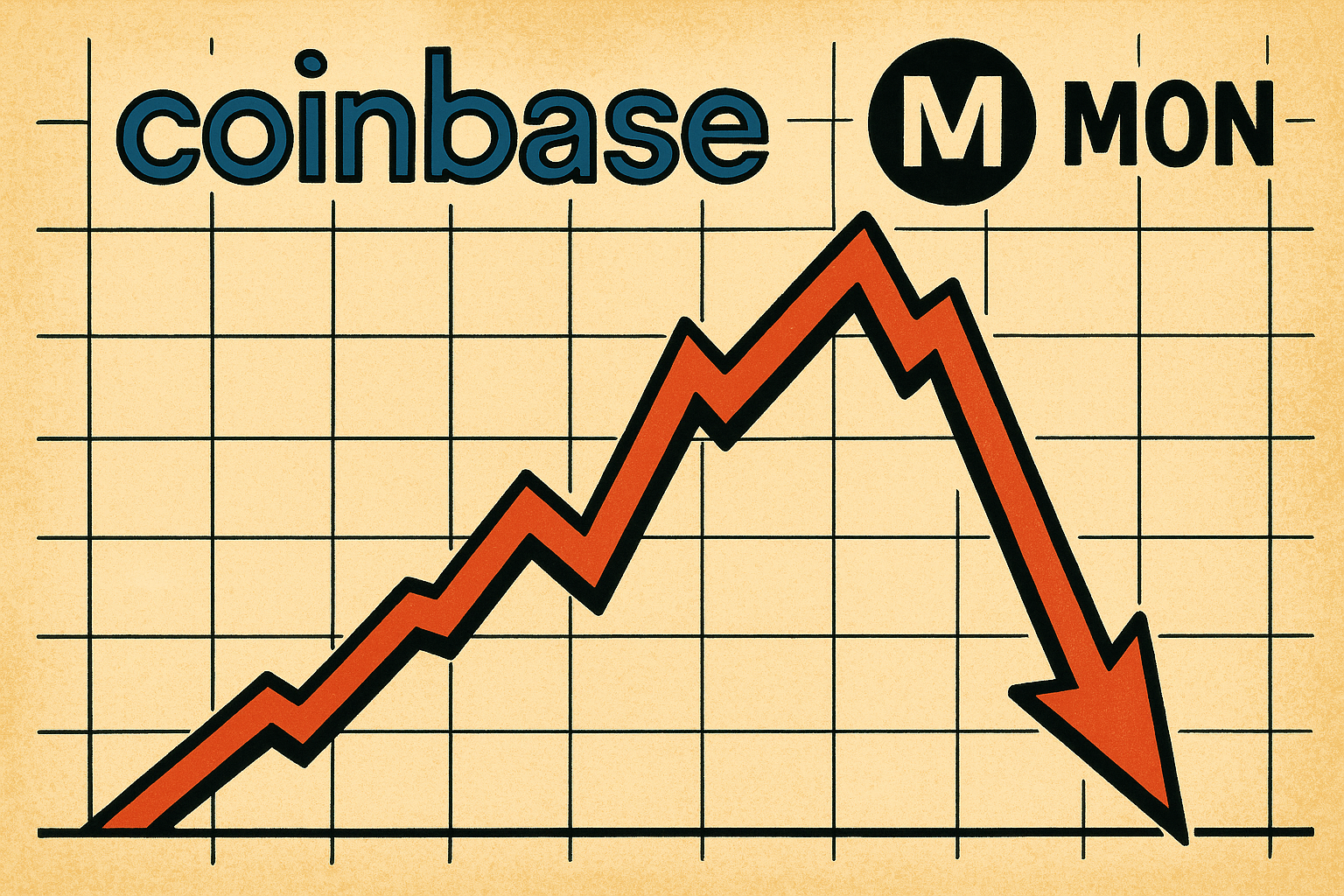News
Centralized Clouds, Decentralized Chains: AWS Outage Disrupts Crypto Platforms, But Not Blockchains

- Share
- Tweet /data/web/virtuals/383272/virtual/www/domains/theunhashed.com/wp-content/plugins/mvp-social-buttons/mvp-social-buttons.php on line 63
https://theunhashed.com/wp-content/uploads/2025/10/aws-1000x600.png&description=Centralized Clouds, Decentralized Chains: AWS Outage Disrupts Crypto Platforms, But Not Blockchains', 'pinterestShare', 'width=750,height=350'); return false;" title="Pin This Post">
Cloudy Skies for Crypto Services
In the early hours of October 20, 2025, a significant disruption rippled across the digital economy as Amazon Web Services (AWS) suffered a major outage in its US-East-1 region. The impact was swift and widespread, with numerous high-traffic platforms—ranging from communication tools to e-commerce sites—experiencing delays, downtime, or full-blown service outages. Among those affected was Coinbase, one of the world’s largest cryptocurrency exchanges, which reported that many users were unable to access their accounts.
While the outage caused momentary chaos across user interfaces and centralized services, it also exposed a vital distinction within the blockchain industry: the difference between decentralized protocols and the centralized platforms built on top of them.
Platforms Stumble, Protocols Stand Tall
Coinbase was not alone. Trading app Robinhood and several other financial services reported service degradation, a reminder of how heavily the fintech and crypto industries rely on centralized cloud infrastructure like AWS. Yet, as front-end interfaces struggled to load and login systems faltered, the blockchains that underpin these ecosystems marched on without interruption.
Neither Ethereum nor Solana experienced any downtime at the protocol level. The same can be said for Cardano, Avalanche, and Polkadot. Block production, consensus mechanisms, and transaction validations continued seamlessly. These decentralized networks, supported by geographically distributed validator nodes, proved resilient in the face of infrastructure failure.
In fact, while user-facing services hit by the AWS outage saw traffic disruptions, data shows that the blockchains themselves continued to process transactions, maintain uptime, and preserve ledger integrity. Validators running on diverse infrastructure providers beyond AWS were able to maintain consensus without issue.
The Centralization Risk in Crypto Infrastructure
What this event underscores is a long-standing vulnerability in the blockchain ecosystem: centralization at the infrastructure layer. While the ethos of blockchain is rooted in decentralization, many of its critical components—APIs, front ends, wallets, and exchange services—are still tied to centralized services for hosting and computation.
Coinbase’s reliance on AWS, while not unique, demonstrates the bottleneck that can occur when too many essential services are tied to a single cloud provider. The same applies to countless decentralized apps (dApps) that, ironically, run on centralized backend infrastructure.
This dissonance is not new. Previous cloud outages have triggered similar reflections within the Web3 space, but today’s disruption brings renewed urgency to decentralize more layers of the stack. Platforms like IPFS and Arweave have attempted to address decentralized storage, while protocols such as Pocket Network aim to decentralize RPC (remote procedure call) endpoints. Still, mainstream adoption of these alternatives has been slow.
Solana, Cardano, and the Case for Distributed Resilience
Solana, often criticized in the past for network outages due to internal technical issues, had no reported interruptions during the AWS failure. This marks a notable contrast from prior incidents and signals the network’s maturing infrastructure. Cardano, which emphasizes academic rigor and formal verification in its development, similarly reported no disruptions.
These blockchains benefit from a more distributed validator architecture, which limits exposure to any single point of failure. The ability of networks like Cardano and Solana to remain fully operational even as major platforms falter is a compelling argument for the robustness of decentralized systems.
Rethinking Infrastructure Strategy
The AWS outage is a reminder that decentralization cannot stop at the blockchain protocol. Exchanges, wallets, and dApps must reevaluate their infrastructure strategies. Multi-cloud deployments, decentralized hosting, and peer-to-peer data delivery are not just technical enhancements; they are strategic imperatives for an industry that claims resilience as a core value.
As regulators, investors, and users assess the fallout from this outage, the projects that continue to function without pause may gain a new layer of credibility. Meanwhile, centralized platforms face questions about their redundancy planning and operational security.
In the end, the outage served not just as a technical hiccup but as a philosophical checkpoint. If Web3 is to fulfill its promise, it must extend decentralization beyond its consensus algorithms into every layer of its digital stack.
Conclusion: A Call to Decentralize the Full Stack
While major blockchains like Ethereum, Solana, and Cardano survived the AWS outage unscathed, their success also highlights the fragility of the centralized services that rely on them. This incident isn’t just a story of downtime—it’s a prompt for the crypto industry to revisit the foundations of its infrastructure strategy. Resilience in the blockchain age will depend not just on the security of smart contracts but on the diversity and decentralization of the cloud itself.
Ethereum
Small Kingdom, Big Move — Bhutan Stakes $970 K of ETH via Figment to Back National Blockchain Ambitions

Bhutan Turns Heads With Institutional‑Grade ETH Stake
The government of Bhutan quietly moved 320 ETH — worth roughly $970,000 — to Figment, the well-known staking provider, signaling a major shift in how the Himalayan kingdom engages with crypto. Rather than a speculative or retail‑style buy, this is an institutional‑level stake: the amount deployed corresponds to 10 full Ethereum validators (since each validator requires 32 ETH).
More Than Just Yield: Bhutan Anchors Crypto in Governance
Bhutan’s ETH stake comes on the heels of a far broader crypto‑adoption push. In October 2025 the country launched a sovereign national digital identity system — built not on a private chain, but on the public Ethereum blockchain. The decision to anchor citizen identities on a decentralized, globally supported network like Ethereum underscores a long‑term vision: decentralized identity, on‑chain transparency, and national infrastructure built with blockchain.
For Bhutan, this ETH stake isn’t about short‑term price swings or hype — it reflects a strategic bet on Proof‑of‑Stake infrastructure. By running validators via Figment, the government contributes to network security, potentially earns rewards, and aligns its own holdings and governance systems with the protocols underlying its digital‑ID rollout.
What This Signals for Ethereum — and for Crypto Governance
Though 320 ETH is a drop in the bucket compared to total staked ETH globally, the move carries symbolic weight. A sovereign state publicly committing funds to ETH staking via a recognized institutional provider adds to the broader narrative: that Proof‑of‑Stake networks are maturing, and that blockchain can underpin more than speculative assets — it can support identity, governance, and long-term infrastructure.
Moreover, it highlights that institutional staking services like Figment are increasingly trusted not only by hedge funds or corporations, but by governments. According to Figment’s own data, their Q3 2025 validator participation rate stood at 99.9%, and they reported zero slashing events — underlining the reliability such clients are counting on.
What to Watch Next
Will Bhutan stake more ETH? On‑chain data shows the wallet still holds a portion of ETH that remains unstaked — suggesting potential for future validator additions.
Will other nations follow suit? If Bhutan’s mixed use of crypto — combining reserve assets, public‑service infrastructure, and staking — proves viable, it could serve as a blueprint for other smaller states looking to modernize governance with blockchain.
Will this affect ETH’s valuation? Hard to say immediately. The 320 ETH is unlikely to move market prices by itself. But if this step becomes part of a larger trend toward institutional and sovereign staking, the cumulative effect on demand and network security could indirectly support ETH’s long-term value proposition.
Altcoins
Meme Coins Are Losing Their Mojo — From 20 % of Crypto Buzz to Just 2.5 % This Year

Meme‑Coin Hype Takes a Hard Hit
A recent report shows that collective interest in meme coins has plunged from about 20 % of all crypto chatter in late 2024 to roughly 2.5 % by October 2025 — a collapse of nearly 90 %. This shift reflects not only a drop in social buzz but also a broader retreat of speculative enthusiasm across the market. What once felt like the wild west of crypto — rapid launches, viral marketing and huge price swings — is cooling fast.
Market Metrics Confirm the Slide
The decline isn’t just anecdotal. Over the past year, more than 13 million meme tokens flooded the market, many with little to no utility — and most quickly vanished or failed. In a sector built on hype, many of these coins turned out to be short‑lived bets. Overall, the fully diluted market capitalization of memes has dropped by nearly 50 % year‑to‑date, according to blockchain analytics firms.
Trading volume has also cratered. In the first quarter of 2025, memecoin trading volume reportedly fell by 63 %. In many markets, memecoins’ share of overall trading volume dropped below 4 %, marking a dramatic retreat from their previous prominence.
What’s Driving the Decline
The collapse appears driven by a mix of oversaturation, weak fundamentals, and shifting investor preference. The meme‑coin ecosystem became overcrowded — tens of millions of projects launched, many with no clear roadmap or utility beyond chasing quick returns. That oversupply, combined with a broader crypto market slump, has wreaked havoc on liquidity and investor confidence.
Some analysts also cite growing regulatory scrutiny and a rising demand for real utility and transparency rather than hype‑driven “get‑rich‑quick” schemes. Meanwhile, capital and attention are rotating toward more tangible crypto sectors — such as AI‑powered tokens, infrastructure projects, DeFi, privacy coins and even traditional‑finance–style crypto instruments.
Could This Be a “Generational Bottom”?
Some within the community argue that the crash may bottom out soon — and that a new cycle could follow. Once the “dead weight” of unsustainable projects is cleared out, more serious, utility‑driven tokens could regain attention. Others believe the meme‑coin era may be effectively over — that the speculative mania has dissipated, and unless a meme coin brings real innovation or value, investors will avoid it.
Broader Implications for Crypto Markets
The downfall of meme coins underscores a broader maturation of the crypto industry in 2025. Markets appear to be shedding excess speculation and gravitating toward assets with fundamentals. This could lead to healthier ecosystem growth, better token design, and more sustainable long‑term investment — but also less room for high‑risk, high‑reward “moonshot” plays that defined crypto’s early years.
Altcoins
NYSE Arca Files to Launch Altcoin-Focused ETF

Fresh Rule‑Change Proposal Seeks Green Light From SEC
A fresh proposal filed by NYSE Arca could soon bring a new kind of cryptocurrency investment product to the U.S. market. In partnership with asset management giant T. Rowe Price, the exchange is seeking regulatory approval to list an actively managed crypto ETF that goes beyond Bitcoin and Ethereum. If approved, the fund would give investors exposure to a mix of top altcoins—like Solana, XRP, Cardano, and more—through a traditional stock exchange, eliminating the need for wallets, private keys, or crypto trading accounts.
What the Fund Would Do: A Broad, Actively‑Managed Crypto Basket
The Fund isn’t a passive single‑asset product but aims for active management. Its objective is to outperform the FTSE Crypto US Listed Index over the long term.
At launch the Fund intends to hold a diversified basket of “Eligible Assets,” which currently include major tokens such as Bitcoin (BTC), Ether (ETH), Solana (SOL), XRP, Cardano (ADA), Avalanche (AVAX), Litecoin (LTC), Polkadot (DOT), Dogecoin (DOGE), Hedera (HBAR), Bitcoin Cash (BCH), Chainlink (LINK), Stellar (XLM), and Shiba Inu (SHIB).
The Fund may hold as few as five, or as many as fifteen, crypto assets at any given time — and is not strictly tied to the index’s weighting. It may over‑ or underweight certain assets, or include crypto outside the index, guided by active selection criteria such as valuations, momentum and fundamental factors.
The idea is to give investors exposure to a diversified crypto portfolio without having to manage wallets, custody, and rebalancing — while potentially delivering better returns than a static, index‑tracking fund.
Risk Controls, Custody and Governance
To ensure safety and regulatory compliance, the Fund will store its crypto holdings with a dedicated crypto custodian. Private keys will be secured under strict controls, preventing unauthorized access or misuse.
When the Fund stakes any crypto (if staking is employed), it will maintain policies to ensure sufficient liquidity to meet redemptions, especially if a large portion of assets becomes illiquid or locked.
Valuation of the crypto holdings — used to compute Net Asset Value (NAV) per share — will rely on reference rates from third‑party price providers, aggregated across multiple platforms. The NAV will be computed daily, aligned with close of trading on the Exchange or 4:00 p.m. E.T.
Why It Matters for Crypto and Traditional Finance
This filing reflects a broader shift in traditional financial markets embracing diversified, regulated crypto investment vehicles. Unlike earlier spot‑crypto ETFs designed for single assets (e.g., Bitcoin), this Fund proposes a multi‑asset, actively managed basket — potentially appealing to institutional investors and diversified‑portfolio allocators seeking crypto exposure with traditional ETF convenience.
If approved, the Fund would offer a streamlined, compliance‑friendly bridge between traditional capital markets and crypto assets, lowering operational friction for investors who prefer not to deal with wallets, exchanges, or self‑custody.
The approach may also set a precedent: showing that active crypto ETFs can meet listing standards under rules originally written for commodity‑based trusts. This could open the door for more innovation — perhaps funds targeting niche themes (smart‑contract tokens, layer‑2s, tokenized real‑assets) while still abiding by exchange and regulatory requirements.
What’s Next
The SEC review period typically spans up to 45 days from publication (or longer if extended), during which comments from market participants and the public may shape the final decision.
If approved, it may take some additional time before shares begin trading — during which documents like the fund’s prospectus, ETF symbol, and listing date will be finalized and disclosed by the sponsor.
-

 Cardano2 months ago
Cardano2 months agoCardano Breaks Ground in India: Trivolve Tech Launches Blockchain Forensic System on Mainnet
-

 Cardano2 months ago
Cardano2 months agoCardano Reboots: What the Foundation’s New Roadmap Means for the Blockchain Race
-

 Cardano2 days ago
Cardano2 days agoSolana co‑founder publicly backs Cardano — signaling rare cross‑chain respect after 2025 chain‑split recovery
-

 Bitcoin2 months ago
Bitcoin2 months agoQuantum Timebomb: Is Bitcoin’s Foundation About to Crack?
-

 Cardano2 months ago
Cardano2 months agoAfter the Smoke Clears: Cardano, Vouchers, and the Vindication of Charles Hoskinson
-

 Cardano2 months ago
Cardano2 months agoMidnight and Google Cloud Join Forces to Power Privacy‑First Blockchain Infrastructure
-

 Ripple2 months ago
Ripple2 months agoRipple CTO David “JoelKatz” Schwartz to Step Down by Year’s End, but Will Remain on Board
-

 News2 months ago
News2 months agoRipple’s DeFi Awakening: How mXRP Is Redefining the Role of XRP








